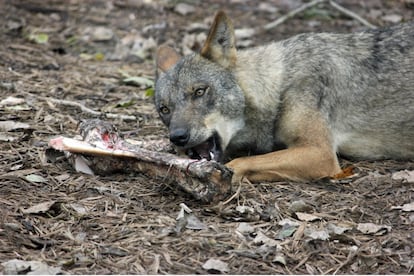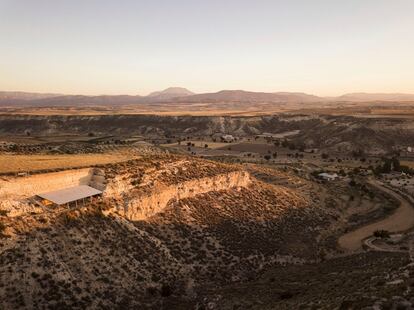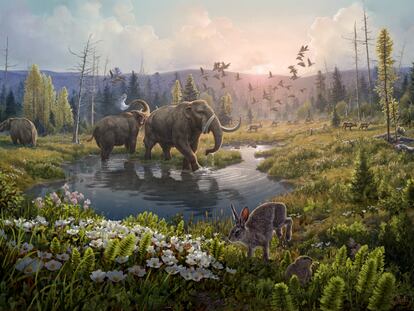Competition for food 1.5 million years ago: Humans first, wolves last
An investigation carried out with artificial intelligence in southeast Spain has found which carnivores, and in what order, used to feed from the same carcasses during the Lower Pleistocene


Getting food was not an easy task during the Lower Pleistocene, approximately 1.5 million years ago, in what is now Orce (Granada), in the southeast of Spain. Or anywhere else, really. When they set out to find something to eat, humans found fierce competition from other unfriendly, carnivorous beasts.
The meat that served as food to humans was the same that the other carnivores ate. This is why organizing the eating order was especially important to them. This arrangement, according to research carried out by the universities of Granada, Salamanca and the Complutense of Madrid, dictated that when there was meat to share, the first to eat were the humans; the last, the wolves. Specifically, the canis mosbachensis, a now-extinct small species of wolf which weighed just over 15 kilos. Between them, other animals took their share, too. In Orce – specifically in the area of Barranco-Leon – this meant saber-toothed tigers, as well as the ancestors of today’s African wild dogs and foxes.

Juan Manuel Jiménez Arenas, researcher and professor of archeology at the University of Granada, has spent many years studying this site. He explains how difficult coexistence was between our ancestors and the animals of that period. “Humans lived in refuge areas. In this specific territory they dwelled in the Sierra de la Umbria,” in what is now Albacete, “and they would descend from the mountains to the hunting and animal area in the current Orce. It was an area with a lot of vegetation. There, the herbivores fed while the carnivores prowled, waiting for some death. And if they didn’t die, they were hunted. It was what is known as the game of life and death. In Orce, in a broad sense, there were shelter areas and hunting areas,” he explains.
When humans were able to descend to the hunting area, they would find a scenario like the one described by Jiménez-Arenas. “In the lower area of the Sierra de la Umbria there was a large saline lake that made human life impossible, but a period of torrential rains caused materials to be dragged into that lake. Then the salt water receded and fresh water appeared. That, along with the fact that many of the materials carried by the water were easy to use by humans to make tools, drove them to settle in the area.” And with them, he adds, many other animals: saber-toothed tigers, reptiles and ancestors of the bear and the hippopotamus, as well as equines, deer, wild dogs and hyenas – the latter capable of breaking bones.
While the mark that humans left on those bones is basically that of the instruments they used to remove or break them in order to extract the marrow, the rest of the animals did leave traces of their bites and tears. Jiménez-Arenas explains that humans “weren’t physically capable of killing, dismembering or removing the flesh, except with the help of tools, as their teeth were blunt and small. Only the largest animals could do that.”
One interesting fact is that, despite the lack of definitive evidence of these human bites in Orce, it is precisely a tooth – a molar found in 2002 – what allowed for the identification of the most ancient human of Western Europe, 1.4 million years old.
Identifying the bites and marks found on the bones was difficult, until now. According to the researcher, the size and type of the animal used to be speculated by looking at the type of bite. Now, new artificial intelligence techniques have made it possible to feed a database with the bites of 613 current animals whose ancestors were known to live in Orce. With it, it has been possible to accurately determine which animals made the marks found on bones unearthed in different excavations. More than 3,500 fossils were examined in this study, obtaining 368 tooth marks from 167 bones, according to the researchers behind an article published in the Quaternary Science Review.
Of them, Jiménez-Arenas points out, only 10% are fractured, which calls into question the fairly widespread belief that the competition between humans and hyenas was very intense. That does not seem to be the case; at least not in this area of southern Europe. However, this is not the subject of this study.
Although it may be obvious, it is important to remember that there are no traces of humans’ plant-based consumption from that time. “Plants hardly leave any evidence in the archaeological record, maybe some pollen that gives us an idea of what they could have eaten, but not what they actually ate,” adds Jiménez-Arenas. But there is enough evidence of their meat consumption through the marks their tools left on the bones.
The results of the comparison between the fossils and the bite mark database indicate that the most frequent one is that of the canis mosbachensis: “Super opportunistic animals that, being small, cannot kill large animals. They probably resembled today’s jackals,” explains the researcher. “If they had to wait for everyone else to finish eating, they did.” Perhaps this is why, when it was their turn, they had to tear to find something to eat; this would explain why their bite is the most common.
According to Jiménez-Arenas, 1.5 million years ago man was more a scavenger than a hunter. “They were primary scavengers. They arrived first at the carcasses.” This fact is known, he explains, because “the entrails are the first thing that is eaten. It is the softest part, the most nutritious and the first to spoil. And we have bones with evidence of evisceration with instruments.” The evisceration was followed by the fleshing and cutting of the pelvis, ribs and other parts. Then, the remains left by the humans served to feed the rest of the animals until, finally, the wolves arrived. “They wouldn’t need much, anyway, because they were small,” he points out.
Magnifying glass vs. artificial intelligence
Artificial intelligence was developed in the 21st century. The magnifying glass was invented by an English monk called Roger Bacon in the 13th century. However, a difference of almost eight centuries does not make these instruments incompatible; quite the contrary. “Artificial intelligence by itself does not solve any problem,” states Jiménez-Arenas. Everything still begins with a magnifying glass, because the first decision in these investigations is made by a human. “All the bones are first looked through the geologist’s magnifying glass, and every last square millimeter of their surface is scrutinized. Then it goes to the scanner and the automated process begins, which we consider good if the correspondence between the mark on the fossil and the database exceeds 90%,” concludes the researcher.
Sign up for our weekly newsletter to get more English-language news coverage from EL PAÍS USA Edition
Tu suscripción se está usando en otro dispositivo
¿Quieres añadir otro usuario a tu suscripción?
Si continúas leyendo en este dispositivo, no se podrá leer en el otro.
FlechaTu suscripción se está usando en otro dispositivo y solo puedes acceder a EL PAÍS desde un dispositivo a la vez.
Si quieres compartir tu cuenta, cambia tu suscripción a la modalidad Premium, así podrás añadir otro usuario. Cada uno accederá con su propia cuenta de email, lo que os permitirá personalizar vuestra experiencia en EL PAÍS.
¿Tienes una suscripción de empresa? Accede aquí para contratar más cuentas.
En el caso de no saber quién está usando tu cuenta, te recomendamos cambiar tu contraseña aquí.
Si decides continuar compartiendo tu cuenta, este mensaje se mostrará en tu dispositivo y en el de la otra persona que está usando tu cuenta de forma indefinida, afectando a tu experiencia de lectura. Puedes consultar aquí los términos y condiciones de la suscripción digital.
More information
Archived In
Últimas noticias
Reinhard Genzel, Nobel laureate in physics: ‘One-minute videos will never give you the truth’
Pinochet’s victims grapple with José Antonio Kast’s rise in Chile
How Japan is trying to avert ‘digital defeat’
The complicated life of Francesca Albanese: A rising figure in Italy but barred from every bank by Trump’s sanctions
Most viewed
- Pablo Escobar’s hippos: A serious environmental problem, 40 years on
- Why we lost the habit of sleeping in two segments and how that changed our sense of time
- Charles Dubouloz, mountaineering star, retires at 36 with a farewell tour inspired by Walter Bonatti
- Trump’s obsession with putting his name on everything is unprecedented in the United States
- The Florida Keys tourist paradise is besieged by immigration agents: ‘We’ve never seen anything like this’










































